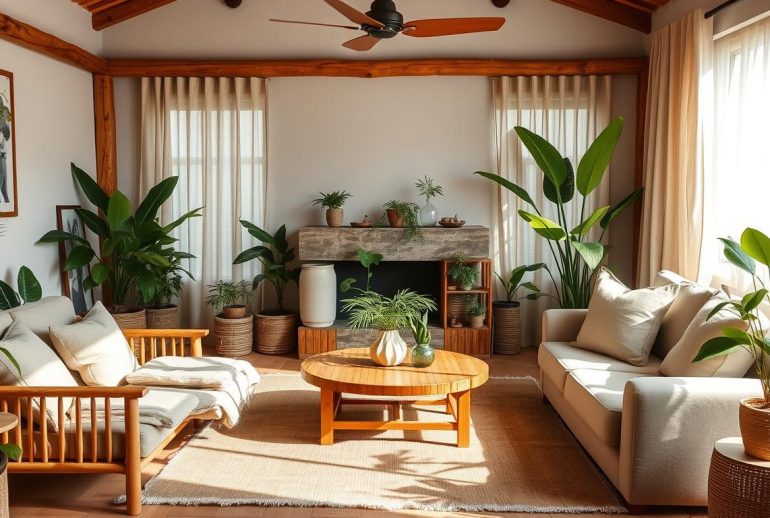Thinking about updating your home this year? Look into sustainable interior design trends. These trends make your home look great and help the planet. They focus on using eco-friendly materials and saving energy, making your home both stylish and green.
Choosing sustainable interior design is a big step. It helps lower your carbon footprint and makes your home healthier. Trends include using recycled materials, letting in natural light, and picking furniture that’s good for the planet. These choices are key to a greener future.
Key Takeaways
- Embracing sustainable interior design contributes to a healthier environment
- Eco-friendly home design reduces carbon footprint and creates a healthier living space
- Green living principles enhance the aesthetic appeal of your space
- Using recycled materials is a key aspect of sustainable interior design
- Incorporating natural light is essential for energy-efficient solutions
- Selecting eco-friendly furniture pieces supports sustainable home trends
The Evolution of Sustainable Interior Design in Modern Homes
When thinking about updating your home, you might be looking into sustainable interior design ideas and eco-conscious decor trends. These trends are becoming more popular as people learn more about climate change. The interior design world is changing to offer more green solutions, focusing on both people and the planet.
Several things are leading to this change:
- Climate change is making designers rethink their designs.
- There’s a big demand for green solutions, pushing the industry to innovate.
- New eco-friendly materials, products, and tech are being developed.
Now, you can pick from many sustainable design options for your home. This includes energy-saving lights and green flooring. By choosing these sustainable interior design ideas, you can lower your carbon footprint and make your home both beautiful and useful.
By going for eco-conscious decor trends and interior design trends, you help make the future greener. You also make your home look better and feel more comfortable. As more people want green design, we can expect even more eco-friendly options in the future.
| Sustainable Design Element | Benefits |
|---|---|
| Eco-friendly flooring | Less carbon footprint, better air quality |
| Energy-efficient lighting | Uses less energy, saves money |
| Sustainable furniture | Less waste, supports green manufacturing |
Biophilic Design: Bringing Nature Indoors
Thinking about making your home greener? Biophilic design might be what you’re looking for. It blends your indoor space with nature, making you feel better and less stressed. Using eco-friendly materials for interiors and sustainable furniture design helps you merge the outdoors with your home.
Here are some ways to bring biophilic design into your home:
- Choose natural materials like wood and stone for your decor
- Add plants and green walls to your space
- Let in as much natural light and air as you can
- Include outdoor features like water features or fireplaces inside
Embracing biophilic design makes your home healthier for you and the planet. With sustainable furniture design and eco-friendly materials for interiors, you can lower your carbon footprint. This helps create a greener future.
Starting your green home journey is exciting. Every choice you make matters. By picking sustainable materials and designs, you’ll have a beautiful, eco-friendly home. Biophilic design lets you enjoy nature’s beauty indoors, making your home a haven for well-being and sustainability.
| Design Element | Benefits |
|---|---|
| Natural Materials | Promotes sustainability, reduces carbon footprint |
| Plants and Green Walls | Purifies air, improves mental health |
| Natural Light and Ventilation | Reduces energy consumption, improves physical health |
Recycled and Upcycled Furniture Innovations
Looking to make your home unique and eco-friendly? Think about using recycled materials for your decor. This not only cuts down on waste but also brings a personal touch to your space. You can repurpose old items, like turning old windows into mirrors or making a coffee table from reclaimed wood.
For furniture, choose pieces made from organic textiles or sustainably sourced wood. These options improve your space’s look and help reduce waste. Upcycling old furniture is another great idea. Just refinish a vintage dresser or reupholster a worn-out chair.
Repurposed Material Trends
Popular trends include using old pallets for shelves or making pendant lights from mason jars. These ideas add fun to your space and cut down on waste. Mix different textures and materials, like combining reclaimed wood with metal or natural fibers with recycled plastic.
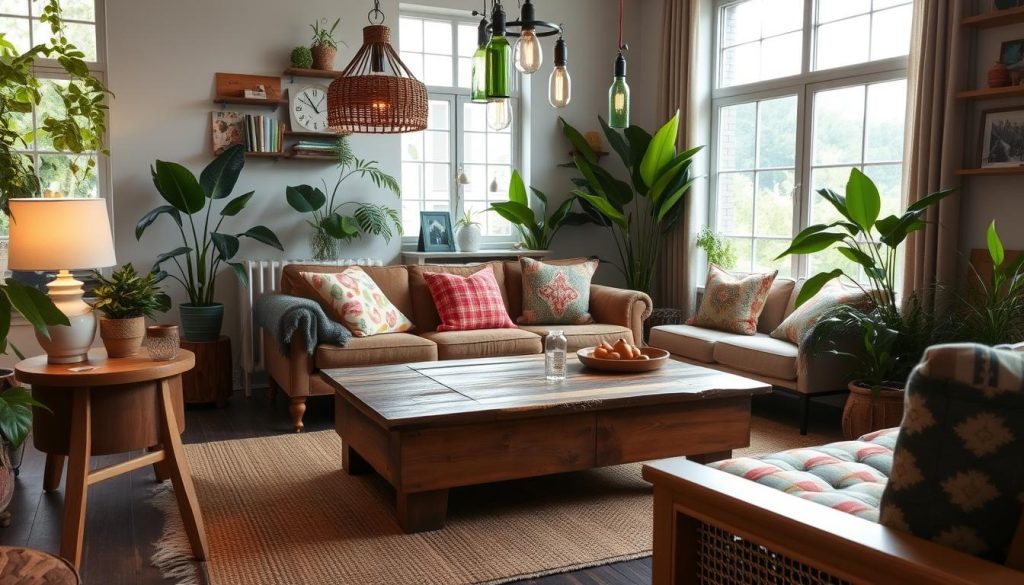
Creative Upcycling Solutions
Here are some upcycling ideas to get you started:
- Make reusable bags or quilts from old t-shirts
- Turn vintage jars into planters or vases
- Use recycled glass for unique lighting or decor
By using recycled materials and low-waste design, you can make a stylish, sustainable space. Have fun and be creative with upcycling. The possibilities are endless!
| Material | Upcycled Product | Benefits |
|---|---|---|
| Reclaimed Wood | Coffee Table | Unique design, reduces waste |
| Old Pallets | Shelves | Space-saving, eco-friendly |
| Natural Fibers | Sofa Upholstery | Sustainable, durable |
Smart and Energy-Efficient Design Elements
Creating a sustainable living space is key. Using smart and energy-efficient design elements is crucial. This includes materials and technologies that cut down energy use, like LED lights and solar panels. These choices help lower your carbon footprint and support a greener environment.
Choosing non-toxic home furnishings is also important. Look for natural fiber rugs, organic mattresses, and other eco-friendly items. These can improve air quality and health. Plus, zero-waste interior design tips, like reducing paper waste and using reusable items, help lessen environmental harm.
Here are some ways to make your home energy-efficient:
- Use energy-saving appliances and lights
- Choose natural materials and textures
- Maximize natural light and air flow
By following these tips, you can make a home that’s not just beautiful but also sustainable and eco-friendly.
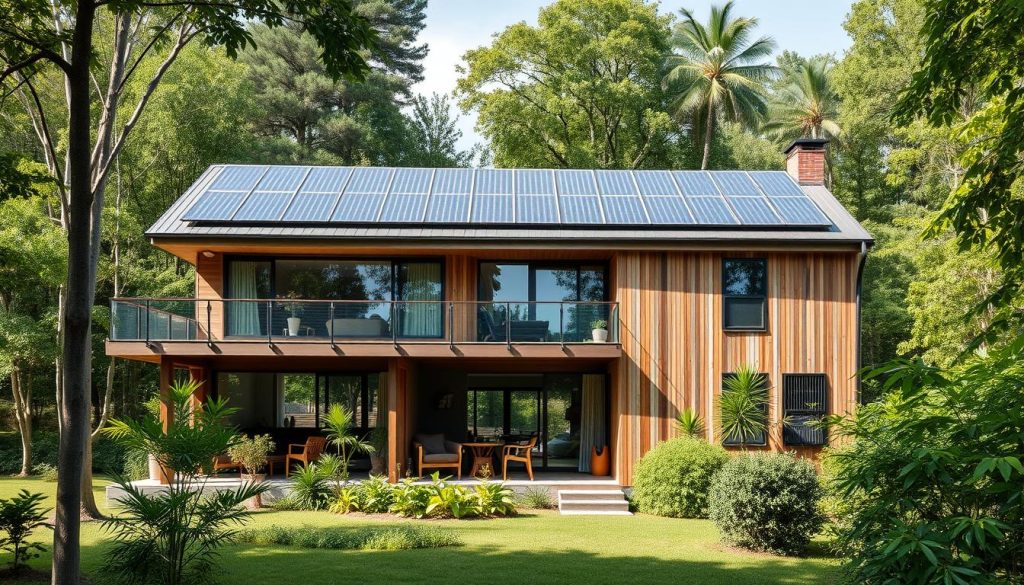
Every small change matters. Making smart choices in your home’s design can greatly benefit the environment. Focus on energy-efficient design, non-toxic furnishings, and zero-waste tips to create a stylish, sustainable space.
| Design Element | Benefits |
|---|---|
| Energy-Efficient Lighting | Less energy use, lower bills |
| Non-Toxic Home Furnishings | Better air quality, better health |
| Zero-Waste Interior Design | Less environmental harm, less waste |
Sustainable Materials Revolutionizing Interior Design
Starting a sustainable home journey means looking at the materials you choose. Eco-friendly materials can make your home better for the planet and your health. It’s key to pick the right materials for a sustainable interior.
Bamboo, cork, and reclaimed wood are top choices. They’re strong and add a special look to your space. Bamboo floors and cork walls are gaining fans for their green and lasting qualities. Using old wood for furniture and floors brings elegance and cuts down on waste.
For small spaces, new eco-textiles are great. Organic cotton and recycled polyester make comfy, stylish covers and curtains. These materials are good for the planet and make your home look great. They help you create a green, cozy space.
Using green materials in design has many perks:
- It’s better for the planet.
- It’s healthier for you.
- It looks unique and classy.
- It lasts a long time.
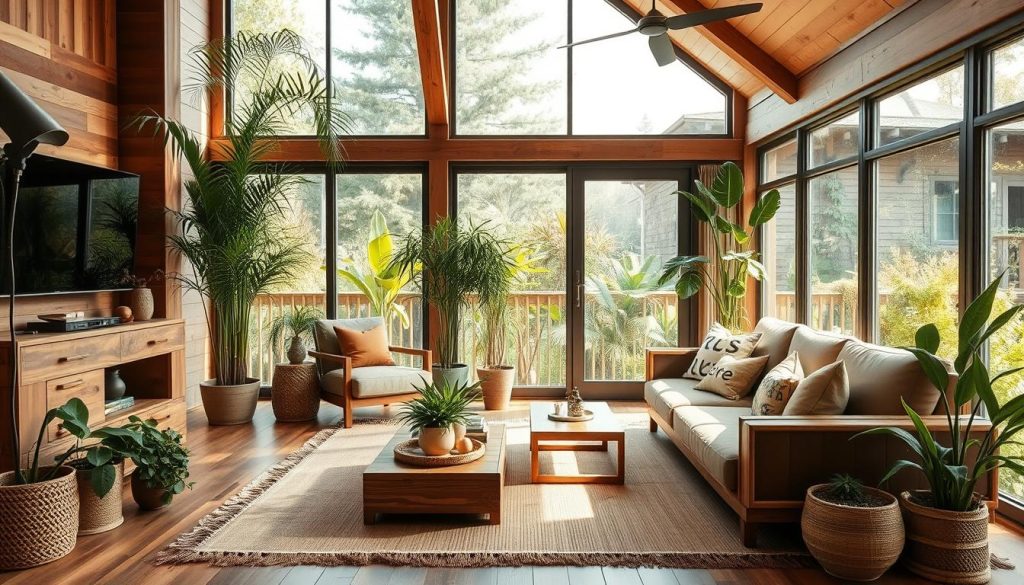
Choosing green materials makes your home beautiful and eco-friendly. Whether you’re searching for inspiration or just want to go green, there are many options. You can make your space stunning and sustainable.
| Material | Benefits | Applications |
|---|---|---|
| Bamboo | Durable, sustainable, eco-friendly | Flooring, walls, furniture |
| Cork | Insulating, durable, sustainable | Walls, flooring, furniture |
| Reclaimed Wood | Unique, elegant, reduces waste | Furniture, flooring, walls |
Natural Light Optimization and Energy Conservation
Natural light in interior design is key for a sustainable home. It cuts down on the need for artificial lights, saving energy. Adding plants or green walls does more than clean the air; they also bring in more natural light.
To boost natural light, think about mirrors, skylights, or bigger windows. They reflect and spread light, cutting down on the need for artificial lights. Also, choose sustainable furniture design to save energy. Opt for eco-friendly materials and furniture that uses less waste.
Here are some tips for better natural light and energy saving:
- Use light-colored walls and floors to bounce natural light around.
- Install solar tubes or skylights to let in more natural light.
- Add plants or green walls to clean the air and enhance natural light.
- Choose energy-saving lights like LED bulbs.
By using these ideas, you can make a space that’s not just pretty but also good for the planet. Every little change helps, and focusing on natural light and energy saving is a big step towards a greener home.
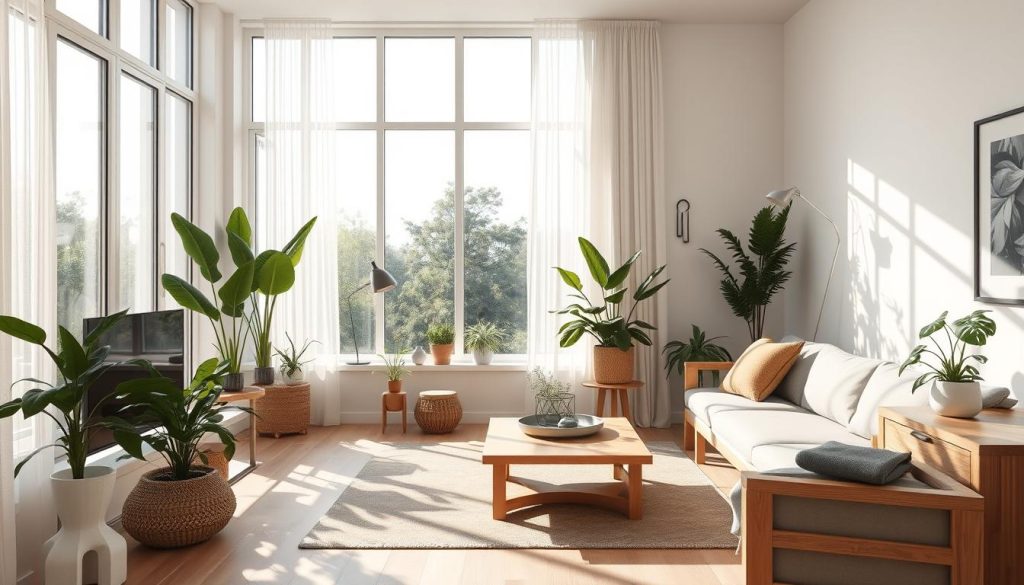
Remember, as you design your space, don’t forget the role of natural light in interior design, biophilic design ideas, and sustainable furniture design. They’re all important for a green and eco-friendly home.
Zero-Waste Design Strategies for Modern Living
Creating a sustainable living space is key. Using zero-waste interior design tips is crucial. By choosing eco-friendly home design, you can lessen your environmental impact. Adopting minimalist storage solutions helps keep your home tidy and organized.
Choosing multipurpose furniture is smart for sustainable living. For example, a storage ottoman as a coffee table saves space and reduces waste. Using reusable products and cutting down on paper waste also helps achieve a zero-waste lifestyle.
Key Principles of Zero-Waste Design
- Choose multi-functional furniture pieces to reduce clutter and promote efficiency
- Opt for reusable products and materials to minimize waste
- Incorporate eco-friendly home design elements, such as recycled materials and sustainable textiles
By following these principles, you can make your home beautiful and sustainable. Every small change helps the environment. Adopting zero-waste interior design tips makes a big difference.
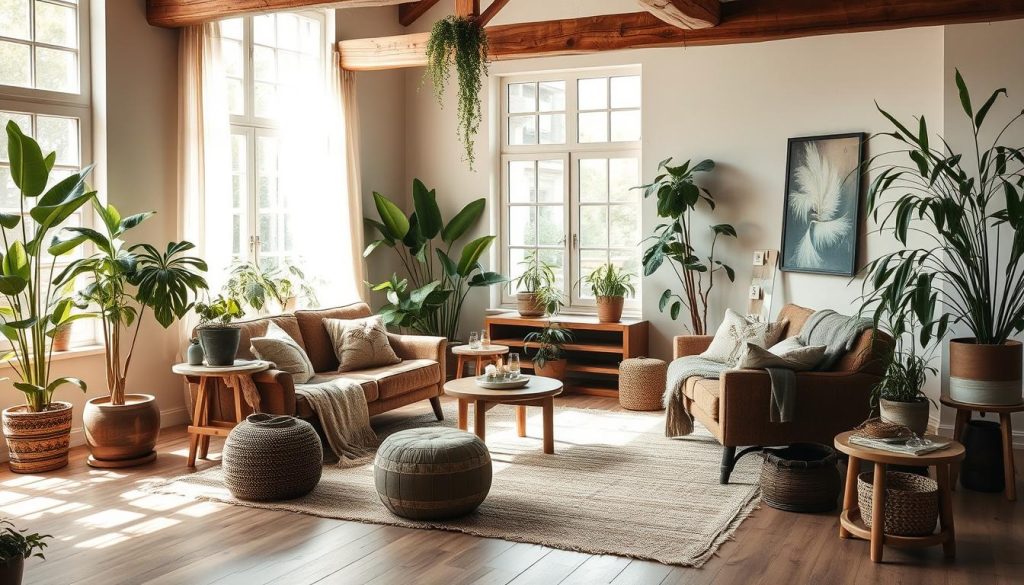
Starting a zero-waste home journey is exciting. Look into sustainable home trends and eco-friendly design. With creativity and planning, you can make a stunning, eco-conscious home to be proud of.
Non-Toxic and Organic Interior Elements
Creating a healthy and sustainable home is key. Non-toxic and organic interior elements are essential. Start with natural fiber rugs and organic mattresses to improve air quality and health. Organic textiles for interiors, like organic cotton and recycled polyester, make sustainable upholstery and window treatments.
Eco-friendly materials like reclaimed wood and bamboo are also great. They help make your home non-toxic and organic. Here are some popular choices:
- Natural fiber rugs made from sisal, jute, or seagrass
- Organic mattresses made from natural latex or cotton
- Reclaimed wood furniture, such as coffee tables or shelves
- Bamboo flooring or wall panels
Choosing these elements makes your home beautiful, healthy, and sustainable.
Every small change helps. Adding non-toxic home furnishings, organic textiles, and eco-friendly materials makes a big difference. Start exploring today and make your home healthier and more sustainable for you and your family.
| Material | Benefits | Examples |
|---|---|---|
| Natural Fiber Rugs | Improves indoor air quality, durable | Sisal, jute, seagrass |
| Organic Mattresses | Promotes health, comfortable | Natural latex, cotton |
| Reclaimed Wood | Eco-friendly, unique aesthetic | Coffee tables, shelves |
| Bamboo | Sustainable, durable | Flooring, wall panels |
Living Walls and Sustainable Plant Integration
Creating a healthy, sustainable living space is key. Living walls and plants are great for this. They make your home eco-friendly and support green living. Plants improve air quality, reduce stress, and make your space feel better.
Living walls come in many forms. You can use a trellis or a living wall planter. Succulents, air plants, and ferns are good choices. They’re easy to care for and clean the air.
Vertical Garden Design Options
Vertical gardens save space and improve air quality. You can choose from:
- Using a trellis or a living wall planter
- Creating a living wall with a mix of plants and greenery
- Incorporating air-purifying plants into your design
Low-Maintenance Plant Selection
Choosing easy-to-care-for plants is smart. Succulents, air plants, and ZZ plants are good picks. They’re perfect for those who don’t have time for a lot of plant care.
Air-Purifying Plant Arrangements
Plants that clean the air are great for your home. Peace lilies, spider plants, and snake plants are good choices. They help make your space healthier and more eco-friendly.
Conclusion: Embracing Sustainable Design for a Better Future
Exploring sustainable interior design shows us that eco-friendly choices are here to stay. They help us create spaces that are good for us and the planet. By choosing sustainable design, you make your home look great and help the environment.
Choosing recycled furniture, using energy-saving designs, and loving natural materials can make a big difference. Your choices can lead to a better future. By supporting sustainable design, you help create a cleaner, greener world for all.
FAQ
What are some of the top sustainable interior design trends to follow this year?
This year, top trends include using recycled materials and natural light. Also, choosing eco-friendly furniture is key. Sustainable design focuses on green materials, energy saving, and waste reduction.
How has the evolution of sustainable interior design impacted modern homes?
Sustainable design in homes has grown due to environmental concerns. It’s influenced by climate change and the need for eco-friendly spaces. Designers are now creating new, green materials and products.
What is biophilic design, and how can it bring nature indoors?
Biophilic design brings nature inside, blending the built world with nature. It uses natural materials and plants to improve health. This design makes spaces feel more natural and calming.
What are some of the innovations in recycled and upcycled furniture design?
Recycled furniture is gaining popularity for its eco-friendliness. Designers use old materials like wood and metal to create unique pieces. Upcycling, like turning pallets into furniture, adds sustainability to any room.
What are some of the smart and energy-efficient design elements to consider?
Smart design uses energy-saving materials and tech. LED lights and solar panels cut energy use. Choosing non-toxic items improves air quality and health. Zero-waste design reduces environmental impact.
How are sustainable materials revolutionizing interior design?
Sustainable materials are changing design with eco-friendly options. Bamboo and cork are popular for their durability. Reclaimed wood and organic textiles add uniqueness and reduce waste.
How can natural light optimization and energy conservation contribute to sustainable interior design?
Natural light and energy saving are key for sustainability. Skylights and mirrors reduce artificial lighting needs. Biophilic design and eco-friendly furniture also help conserve energy.
What are some zero-waste design strategies for modern living?
Zero-waste design aims to reduce waste and promote sustainability. Minimalist storage and multipurpose furniture cut down on waste. Using reusable products and reducing paper waste also help achieve a zero-waste lifestyle.
What are some non-toxic and organic interior elements to consider?
Non-toxic elements improve health and sustainability. Natural rugs and organic mattresses enhance air quality. Eco-friendly materials like bamboo and organic textiles make spaces healthier.
How can living walls and sustainable plant integration enhance a sustainable interior design?
Living walls and plants boost health and sustainability. Vertical gardens and low-maintenance plants save space and improve air. Air-purifying plants remove toxins, making spaces healthier.

